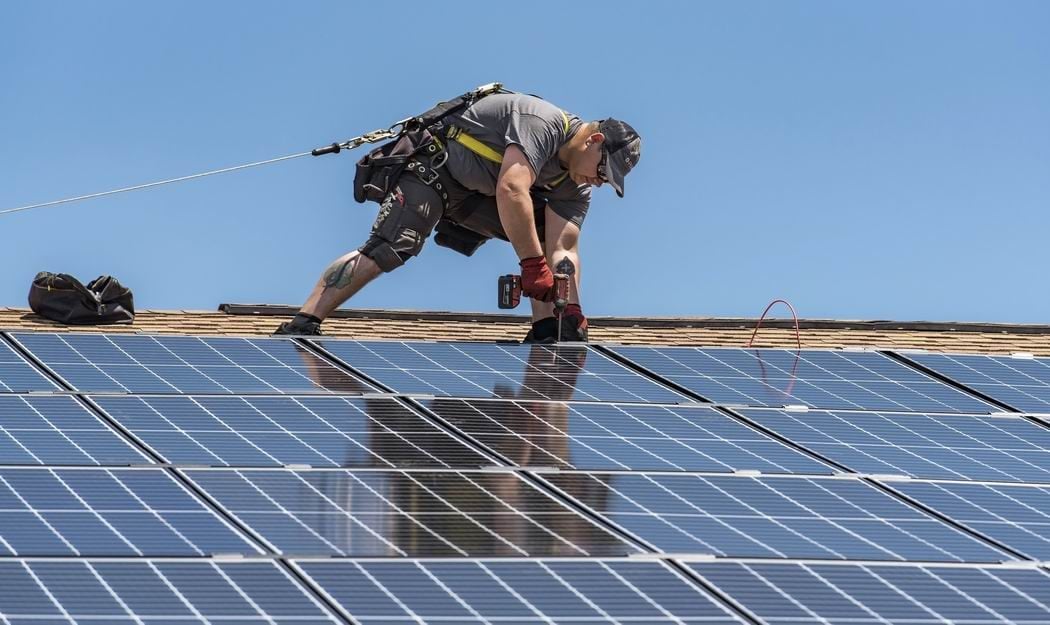Our homes contribute to climate change, and failing to act, and act now, is a direct threat to us and our descendants, as a new Canadian report shows. We know this, and if you’re reading this and have doubts, or think that this is someone else’s problem, this article isn’t going to help you. It is up to every one of us to do our part and do it now.
But many might wonder what they can do, as individuals, as homeowners, to reduce climate change. Sure, getting an electric car helps, but for many, this isn’t practical or financially realistic. With government cutbacks on subsidies and our car-centric planning model, many of us need a car. Or do we?
As they say in real estate, location is everything. One of the first steps a homeowner can take is to consider their location. Choosing to live near good transit and in a community with good walkable or bikeable connections is a great first step. Being able to take your bike to nearby transit, or pick up groceries walking home from work, makes a huge difference. That can make having a car an occasional need, something that can be met with a car sharing system or rentals.
Bigger homes mean higher energy costs
But let’s look at the actions homeowners can take directly with their house. To begin, we have to think about how much space we need in homes. A recent survey found that, compared to eight other countries, including the U.S., the United Kingdom and Australia, Canadians have the third largest homes. What’s more, 42 per cent of Canadians want even larger homes. In fact, average home sizes have doubled in the last 20 years while the average size of our families has shrunk. We need to wonder if we really need all that extra room.
All that space needs to be heated, cooled, needs lights and power. We have two basic sources of energy: natural gas, which most of us use for furnaces, clothes dryers and stoves, and electricity for our lighting and power to run televisions, computers, ranges, air conditioners and everything else. Some homes still rely on heating fuel oil in place of natural gas; some homes rely on a heat pump system (usually geothermal) as a heating or cooling source.
More: Insulation is the investment that pays off
The basics are easy to understand: if we use less energy to heat, cool or operate our home, we need to put in less energy; less input is better for the environment. When I look at my own utility bills, the gas bill is cheap, but is six times the equivalent kWh of electricity. And with at least 70 per cent of our Ontario electricity grid being from carbon neutral sources, moving away from gas is important to de-carbonize our built environment. But electricity is expensive, so how do we use less of all kinds of energy?
Reducing energy consumption & climate change
When we were kids, we might remember our parents yelling, “Close the door, I’m not heating the outdoors!” The energy loss through open doors is obvious. Extra wall and ceiling insulation, good quality windows and properly sealing doors with weather stripping can make the difference between the furnace running constantly or just occasionally.
In the old days, our homes leaked air, so we just pumped in more heat. Partly, that was because energy (oil, firewood, coal) was cheap and seemed limitless. Today, with tighter building envelopes, we need to use energy recovery ventilators and fans to make sure we exhaust stale indoor air and bring in fresh outdoor air while recovering energy. An ERV, and waste heat recovery from sewer drains, can help minimize the feeling that the heat is flying out an open door.
We also have to focus on the three R’s: reduce reuse and recycle. When it comes to our homes, we need to reduce our energy demands, reuse as much of the potential in energy sources as we can, and use recyclable sources where have no other option.
More: Insulation myths debunked
To reduce our energy demand, we need better insulation, windows and weather stripping; we need to replace energy-intensive appliances with more efficient ones. We need to rethink the amount of exposed structure (this is why middle unit townhouses are more energy efficient than end units) and use the energy we do buy more efficiently.
We need to reuse energy to get the most out of it; ERVs and waste drain heat recovery capture the heat before we literally flush it away. We need to integrate renewable sources like geothermal (ground source) heating and cooling and photovoltatic on-site generation (solar panels) to create the energy we do need from renewable sources.
An investment that yields a good return
Your home is your biggest investment. Most people would see the logic in putting on good roof shingles with a long-term warranty. We’re also quick to splurge on upgrades like granite counters and interlock driveways. But we rarely think of the investment needed in the bones of our home’s infrastructure.
Investing 15 per cent more at the start of construction adds just over $50,000 to the selling price of the average home with an increase of about $300 a month in payments. But if that saved you $300 in utility bills, wouldn’t that be worth doing? Suppose utility rates go up five per cent per year every year; after 10 years, without this investment, you’d be paying close to $500 a month, but by making a smart investment today, you save money in the long run.
Thinking carefully about where and how to live can have a profound impact on our finances while taking concrete steps on climate action. Choosing to live near transit, in an energy-efficient, appropriately sized home, while making a smart investment, isn’t just good for the planet, it’s good for our wallets.

